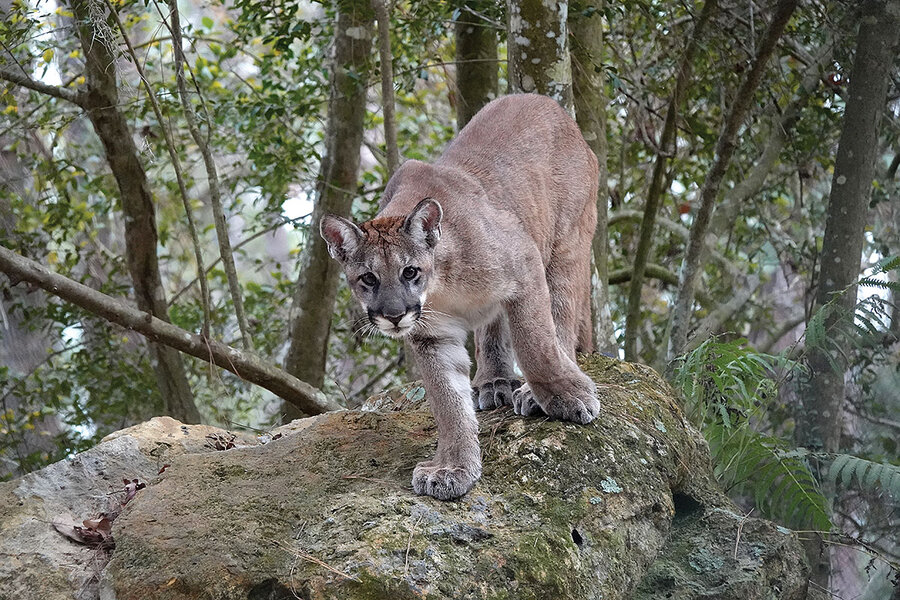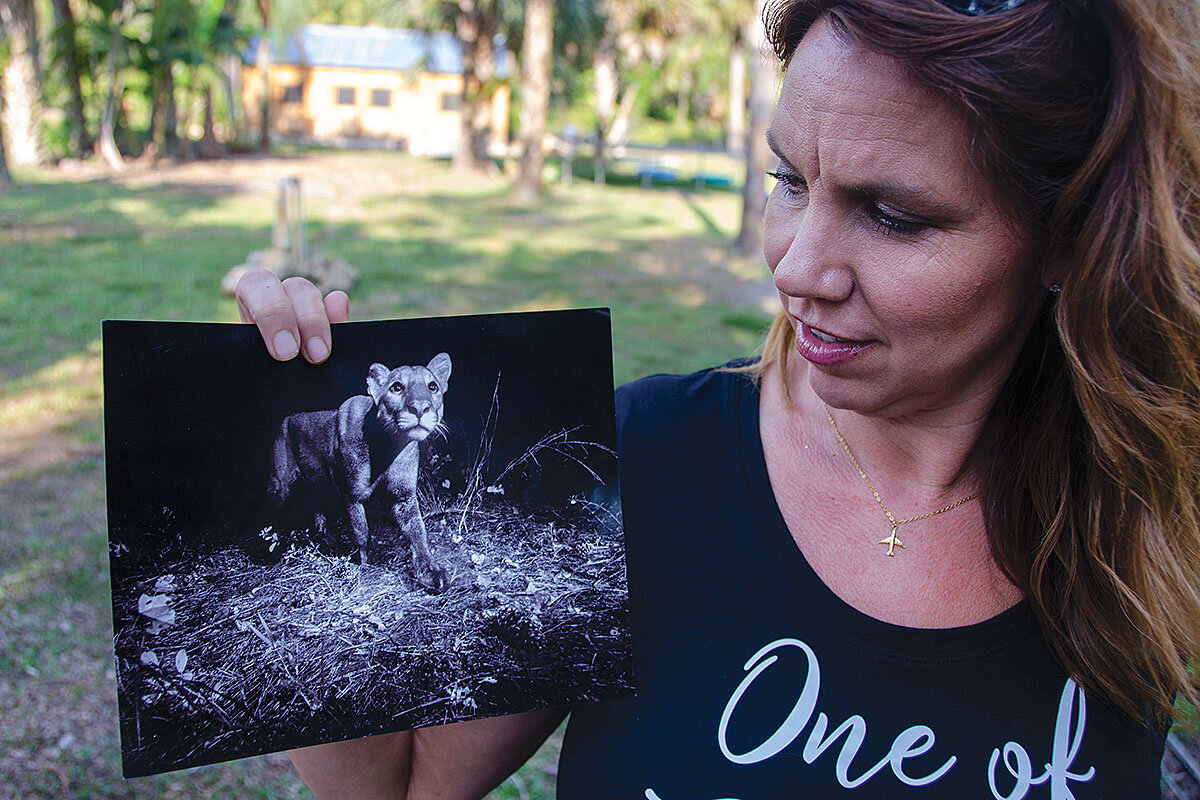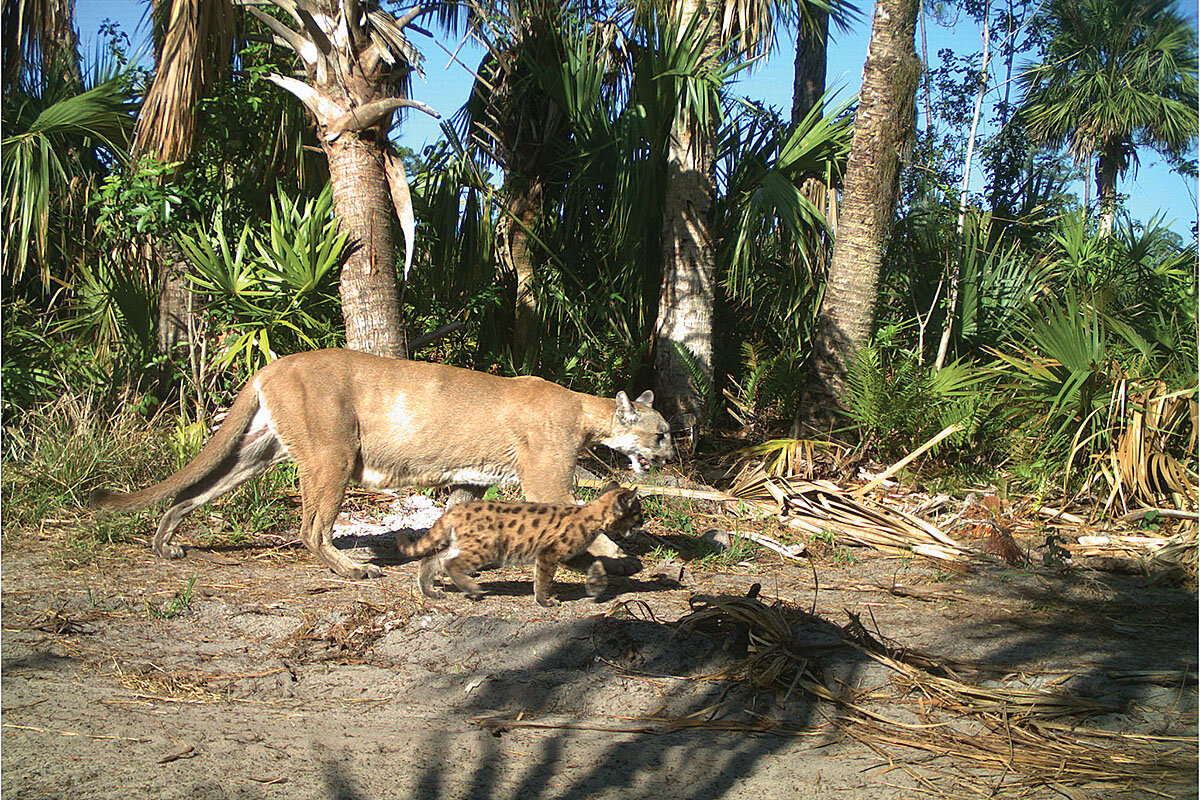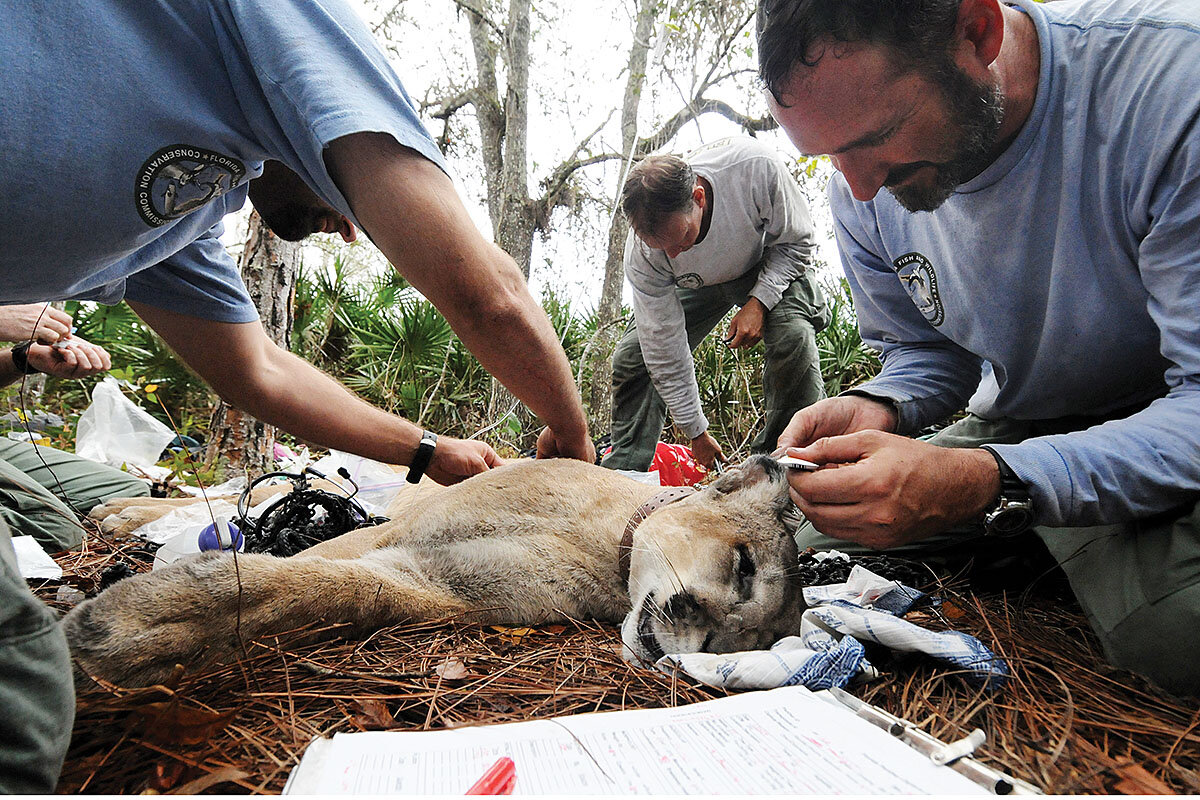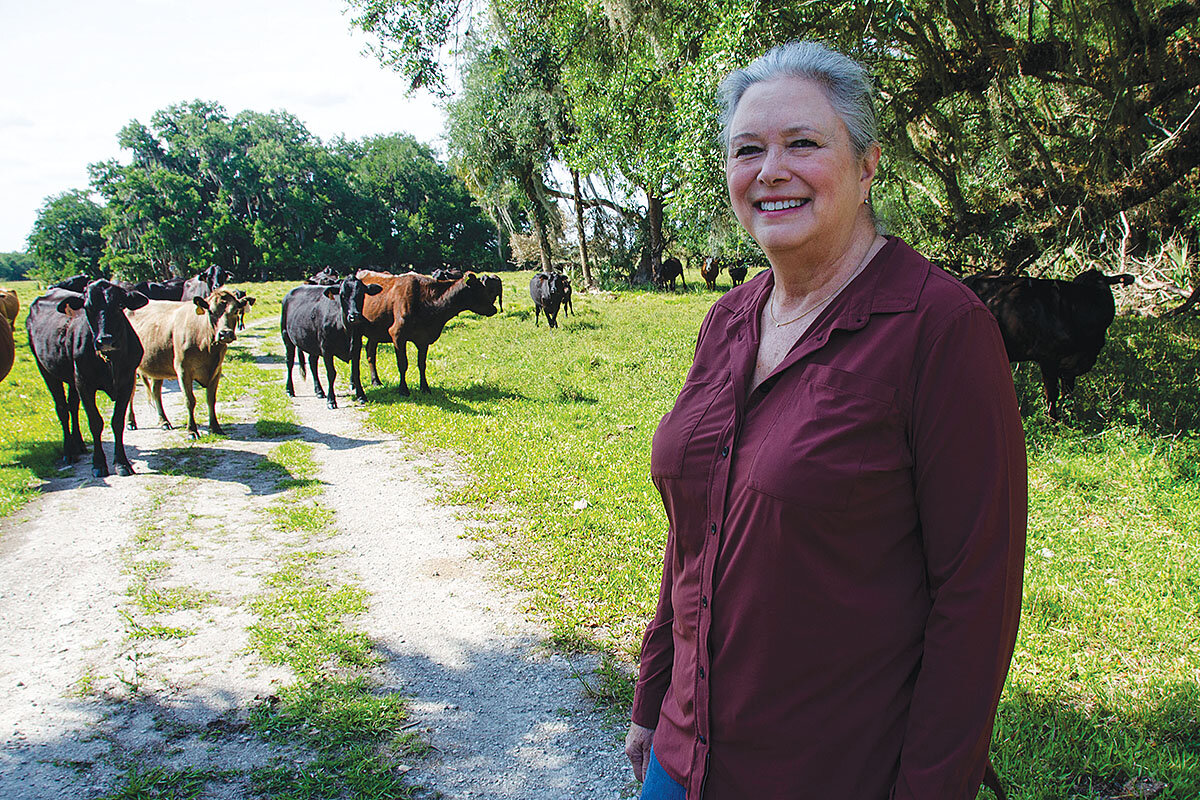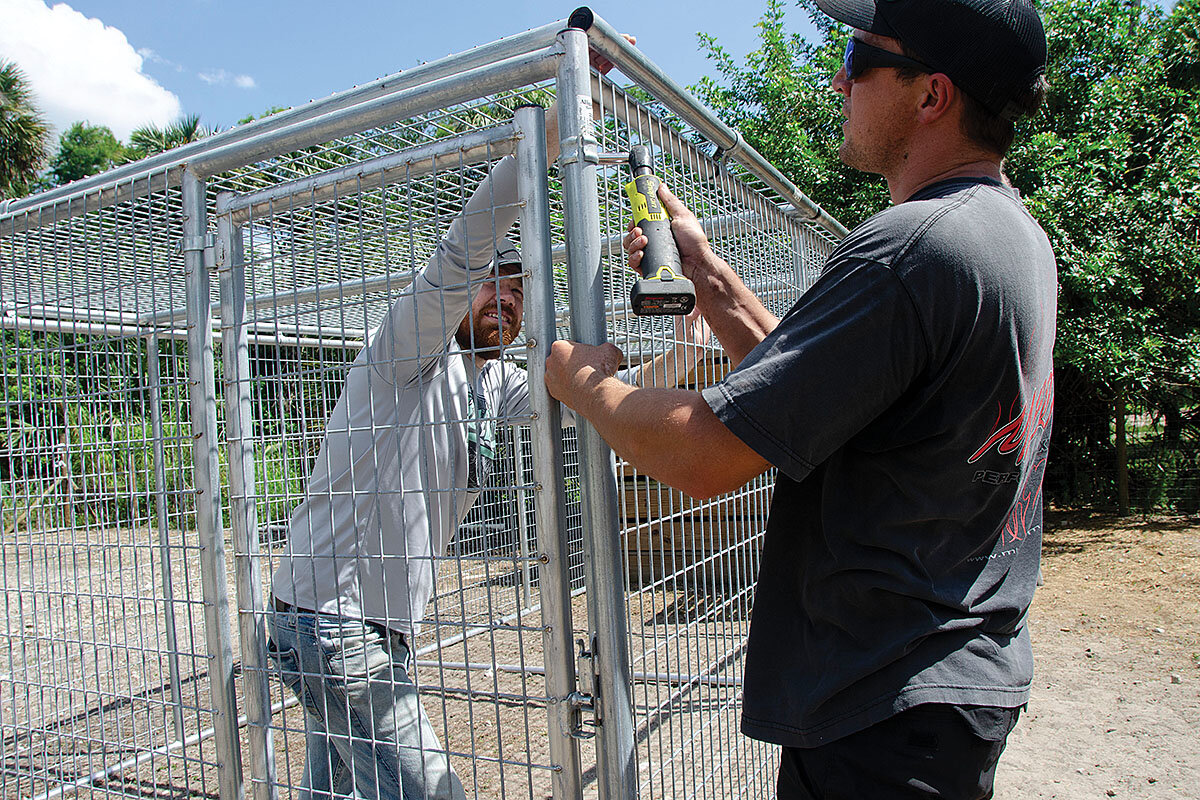Florida brought back its panthers. Can people live with them?
Loading...
| Naples, Fla.
Florida panthers are back. Their hunting forays into backyards are just one sign of a remarkable recovery that began almost three decades ago, when the animal’s population had dwindled to about 30. Now, by contrast, bright yellow signs bearing the words “PANTHER XING” dot Florida roads.
Yet their recovery is far from assured. As the state’s panther population is growing, so is its human population. The cats are pitted against developers, with their plans of gated subdivisions, golf-course communities, and retirement colonies.
Why We Wrote This
The return of the panther in Florida, like the grizzly bear in Montana and the gray wolf in Wisconsin, raises a fundamental question: How can society adapt to large predators that decades of conservation efforts have helped recover?
The panther’s predicament is not unique. It’s a variation on a theme, the problem of how to accommodate large predators that decades of conservation efforts have helped recover in many parts of the country. But if there’s a battle between developers and panthers, there’s also an alliance of sorts between panthers and ranchers.
“If you’re a true rancher, a true conservationist, you’re going to love your land and want to preserve it forever,” says rancher Cary Lightsey.
Across the state, a variety of panther-friendly experiments are underway in both housing development and nature preservation, such as the Florida Wildlife Corridor. Activists hope they’ll strike the right balance between humans and nature.
“There’s no way to stop this development,” says environmentalist Elizabeth Fleming. “Either it’s going to happen in a better way or in a horrible way.”
One day last year, Storm Kahealani and his sister Meadow were playing outside when they came running into the house screaming hysterically. “A panther got Daisy!” Meadow cried as her brother sobbed uncontrollably.
Daisy was a goat. She was one of three dwarf Nubians the family had brought when it moved to Florida from Washington state two months earlier. The family settled on 2 1/2 acres of slash pine, sabal palm, and palmetto scrub in a sprawling semirural housing development on the outskirts of Naples, Florida, called Golden Gate Estates. There was a fenced-in backyard for the goats.
Started in the 1950s, Golden Gate is part suburb, part Wild West. On one side lies Naples, a Gulf Coast city of sand beaches, seafront mansions, and luxury hotels. On the other side is the largest expanse of wilderness east of the Mississippi River, including Everglades National Park, Big Cypress National Preserve, and the Florida Panther National Wildlife Refuge. Golden Gate is an early example of a Florida type: the land venture that lures outsiders into the state’s rural interior with intimations of semitropical paradise. With mile after mile of widely spaced houses, dead-end roads, drainage canals, and more woods and scrub than manicured lawn, Golden Gate is still a beacon for migrants who stream into Florida, young families and graying retirees alike, all looking for a small patch of paradise. It was perfect for goats, too.
Why We Wrote This
The return of the panther in Florida, like the grizzly bear in Montana and the gray wolf in Wisconsin, raises a fundamental question: How can society adapt to large predators that decades of conservation efforts have helped recover?
Perfect, that is, except for the panthers. One of them had leapt the 4-foot chain-link fence into the backyard, grabbed Daisy, and dragged her toward the palms and underbrush beyond. But a hoof got caught in the fence; the panther had to abandon the animal and flee. Storm’s elder sister, Oceane, carried Daisy back into the yard, where she died.
“It was emotionally exhausting,” says Christy Kahealani, the children’s mother.
It was not a rare encounter. Panthers have become frequent visitors in Golden Gate Estates, drawn by the “hobby livestock” – goats, donkeys, mini horses, and other animals – that many residents keep. Along Collier Boulevard, a six-lane avenue separating Golden Gate from the rest of Naples, bright yellow signs warn drivers to watch out for panthers, a reminder of their growing presence.
Florida panthers are back. Their hunting forays into Golden Gate backyards are just one sign of a remarkable recovery that began almost three decades ago, when the animal’s population had dwindled to perhaps 30 and was on the verge of disappearance. Today biologists estimate their numbers at 120 to 230. Increasingly, they roam west into Naples and its suburbs and north, into the farmland, citrus groves, and ranches that extend up the middle of the state toward Orlando.
And yet their recovery is far from assured. With 21.5 million residents, Florida is the third most populous state in the country and one of the fastest growing. Houses are going up quickly in Golden Gate Estates, while gated subdivisions, golf-course communities, retirement colonies, and whole towns are springing up in the Florida interior. The development is crowding the panthers, fragmenting their habitat, and putting more cars on the road – the biggest killers of the wild cats.
Can they survive? Can Floridians learn to live with them?
The Kahealani family has certainly tried. After Daisy died, local wildlife officials descended on the little homestead to investigate the loss and instruct the family how to avoid another. Conservation groups helped build a sturdy chain-link pen to protect the two remaining goats, part of a local program to encourage coexistence with panthers and other carnivores.
Meanwhile, state and federal agencies and conservation groups are protecting important wildlife habitat by buying conservation easements from private landowners. The state highway department is building wildlife crossings. And support is growing for a statewide plan to protect the long wildlife corridors that still provide a link between the Everglades and the big natural areas of northern Florida. On July 1, the Florida Wildlife Corridor Act went into effect, which provides $300 million for land acquisition and preservation to bolster the network. The measure was approved unanimously by the state Legislature.
For the panthers it’s become a race between growth and conservation – a contest between developers and Florida’s influential environmental community, the many groups and individuals who want to defend the state’s rich natural legacy of which panthers are a premier example. The panthers are adaptable. But for now, the developers may be winning.
“It’s death by a thousand cuts,” says Dave Onorato, lead research biologist for the Florida Fish and Wildlife Conservation Commission, the state agency responsible for managing the panthers. “Not one of those developments is going to push them over the edge. But as more and more time passes and more of these developments get approved, there’s less and less habitat available for panthers.”
This is a story not of Florida’s sun-drenched coasts but its wild, mosquito-infested interior, a place of subtropical swamps, saw-grass marshes, wet prairies, and pine flatlands; of alligators, deer, hundreds of different kinds of birds – and alien species like feral pigs and Burmese pythons. It’s also a place of citrus orchards, ranches, tomato and sugar cane fields, and increasingly, housing projects that rise quickly on fields too flat to slow the bulldozer’s crawl.
That’s Florida. It’s long been a magnet for developers, beginning with the promoters who drained the Everglades to turn it into farmland. They straightened rivers, dug canals, emptied swamps, and shrank the Everglades system, which once covered the whole of South Florida, to half its original size. Efforts are underway in many places to undo this damage. The future of the panther is tied up with these, too.
“It’s basically a symbol of wilderness,” says Robert Frakes, a leading panther biologist. “If you have large areas that are wild enough to support panthers, all the species who depend on that ecosystem are also protected.”
The panther’s predicament is not unique. It’s a variation on a theme, the problem of how to accommodate large predators that decades of conservation efforts have helped recover in many parts of the country. The 1966 Endangered Species Preservation Act, and the 1973 Endangered Species Act that followed, threw them a lifeline – animals like grizzly bears in Montana or gray wolves in Wisconsin. They’ve been coming back, creating new controversies and posing fresh challenges to coexistence.
Floridians love panthers. In 1982, school children voted the panther the state animal, picking it over the diminutive Key deer and the fat but lovable manatee. That was also the year that Thomas Trotta, an engineer from Miami, saw his first panther, in Everglades National Park. Mr. Trotta, who later became president of the Friends of the Florida Panther Refuge, says he’s seen panthers 50 times since then.
“I spend a lot of time outdoors,” says Mr. Trotta. “I know their signs. I know how to keep my eyes at a distance.” Even in Golden Gate Estates, where panthers have caused so much trouble, a sighting sends a shiver of excitement through the community. Late one night, a panther’s scream woke Justin Schofield, a local resident. It scared him, but not for long. “I think they’re awesome,” he says.
The panther is a subspecies of mountain lion, an animal that once ranged across North America and survives in the thousands out West. Panthers roamed the whole Southeast, but by the middle of the 20th century hunting and habitat loss had reduced them to a tiny remnant in the Everglades. In 1967, they were among the first endangered animals to receive federal protection. By then the problem was more than low numbers. Inbreeding had weakened the population and inhibited reproduction. The panthers had grown gaunt; their tails were crooked. In 1995 biologists released eight Texas pumas, close cousins to the panther, in South Florida in an effort to introduce genetic diversity into the panther population. It worked.
A broader gene pool has bought time, but it has not guaranteed recovery. The U.S. Fish and Wildlife Service says panthers may be taken off the endangered species list only when three different populations are established. The idea is that distinct but connected populations will ensure enough genetic diversity to enable the panthers to survive indefinitely. But it’s unlikely to happen soon. The only breeding population of panthers is in South Florida. Biologists have identified areas in northern Florida and neighboring states large enough to support other populations. But reintroducing a major predator is contentious, and there is no plan to do it with panthers.
Still, the big cats don’t seem to be waiting. Young males often wander far in search of new territory – Florida panthers have been found in Georgia. But recently, biologists have detected females with kittens north of Florida’s Caloosahatchee River, where they have not been seen since 1973. This has raised hopes that the panthers may be dispersing on their own.
José “Nacho” Benitez, a ranch hand in central Florida, says he saw some. Mr. Benitez works on the Tiger Lake Ranch, just south of Orlando. One morning two summers ago, he went out to turn off an irrigation pump in a small orange grove.
As he walked down a sandy track, Mr. Benitez saw a long-tailed cat in the distance. Sometimes people mistake bobcats for panthers, but the tail gave it away. The panther disappeared into the brush. Another followed, bounding across the track.
“It was just a couple seconds,” says Mr. Benitez. “By the time I got my phone out, they were gone.” A week later, he and another worker found tracks in the grove that looked like those of a female panther and her young.
“They say not many people see one around here,” Mr. Benitez says. “That was neat.”
Mr. Benitz’s experience is consistent with verified sightings in other parts of central Florida. These not only suggest that panthers are moving north, but also demonstrate the importance of ranchland to their long-term recovery.
The many landscapes of the Tiger Lake Ranch tell why. A Florida ranch is not the grassy vista of the Western imagination but usually a mix of open space, trees, and underbrush. There are pastures but also cypress groves, oak hammocks, and pine flatwoods. On the shore of Tiger Lake, cows crowd into a thicket of live oaks, seeking relief from the hot sun. A half-mile away, they graze among scattered pines and clumps of palmetto palm. The trunks of the pines are charred, the ground gray with ash. Ranch hands burned the area recently to control underbrush and encourage new grass.
“The more tender it is, the better for a cow,” Mr. Benitez says of the new vegetation.
It’s also better for deer, wild pigs, and other animals that the panthers prey upon. Not all ranchers welcome panthers – they also kill calves – but many want ranchland preserved and are glad to join forces with conservationists.
“If you’re a true rancher, a true conservationist, you’re going to love your land and want to preserve it forever,” says Cary Lightsey, Mr. Benitez’s boss.
With his white cowboy hat, wide mustache, and craggy features, Mr. Lightsey looks every inch a rancher. His forebears brought cattle to Florida in the 19th century, after the U.S. Army forced the Seminoles out of northern Florida and into the Everglades. Today he worries about ranching’s future.
“What concerns me is we’re losing our land. ... The developers want to make money on it,” he says. “There’s no love for it.”
One way ranchers like Mr. Lightsey protect their land is by selling easements that allow them to continue ranching but bar development. The Lightsey Cattle Co., Mr. Lightsey’s family business, has sold easements to most of its 24,500 acres.
Mr. Lightsey says he welcomes panthers. “I want to show my grandkids panthers, not just pictures of panthers,” he says.
Other ranchers are less enthusiastic. In panther country farther south, calf kills have become a real problem. And probably no operation is deeper in panther country than the JB Ranch, owned and run by Liesa Priddy and her husband, Russell. “We’re ground zero for the panther,” Ms. Priddy says.
The Priddy ranch covers more than 9,000 acres – almost 20 square miles – just north of the Big Cypress National Preserve. The Priddys raise cows, lease land for limestone mining, and rent to farmers. Part of the property is in conservation easement. The Priddy ranch abounds with life, including deer, turkeys, sandhill cranes, alligators – and increasingly, panthers.
“When we first started seeing them, 20 years ago, we would see them on the edges,” Mr. Priddy says. “Over time, as their numbers exploded, we see them everywhere.”
Raising cattle in South Florida means more than tending cows. The Priddys and their workers devote a lot of attention to caring for the land in a way that preserves the mix of trees and open space that’s good for both livestock and wildlife. They have machines to mulch brush and kill invasive weeds. They use prescribed burning when they can. Looking out over a field of waist-high thistles, Ms. Priddy sighs. “It’s a never-ending battle,” she says.
Living with panthers isn’t easy, either. Ms. Priddy thinks there are too many of them, but what rankles her most are not the animals themselves, but the difficulty obtaining compensation when a panther kills a calf. Ms. Priddy estimates that she loses as many as a fifth of her calves each year, maybe half of them to panthers. The U.S. Department of Agriculture compensates ranchers for these kills, but they must document each one. And yet panthers usually drag their prey away and hide or bury it to return to it later. Most kills go undetected.
“If I felt I was adequately compensated for business losses, it would be a lot easier to accept the panther issue,” Ms. Priddy says.
Not far away, a series of projects is underway that will test whether development in rural Florida can be done in a way that accommodates panthers and other wildlife.
Big Collier County landowners want to build three villages just north of the Florida panther refuge, creating the equivalent of a new town of 8,000 houses on existing agricultural fields. County guidelines allow developers to build compact urban communities – no more sprawling Golden Gates – in exchange for protecting farmland and wildlife habitat nearby.
Some conservationists support the plan. To them, building houses on tomato fields while protecting panther habitat is an acceptable trade-off.
“There’s no way to stop this development. ... Either it’s going to happen in a better way or in a horrible way, which is how Florida has generally developed,” says Elizabeth Fleming, Florida representative of Defenders of Wildlife.
Others have pushed back, alarmed by large-scale development so close to the heart of panther country. They say government officials and developers underestimate the habitat loss, ignore the effects of increased traffic, and fail to address other problems. A letter from the U.S. Department of Interior suggested in March that building so close to the panther refuge invited trouble because prescribed burning will send plumes of smoke over the communities. It asked for a pause in the plans. None was granted.
An example of what lies ahead is already close at hand. Just a few miles away, the planned community of Ave Maria rises improbably from tomato fields and ranchland. Established in 2007, it has grown to the size of a small town, with 12,000 residents, private schools, and a Roman Catholic university. It also has restaurants, a water park, a fitness center, tennis and bocce-ball courts, and the one thing without which any South Florida community is incomplete: golf courses. It bills itself as a place of “big town amenities and small town community.” And residents agree.
“It’s a nice community,” says David Bramer, an insurance agent from Houston, Pennsylvania. “It’s a safe community.” He and his wife, Janice, are sitting outside a craft brewery on a balmy afternoon. “People are very friendly,” he says.
The small-town glow of developments like Ave Maria is helping fuel a housing boom that shows little sign of letting up. It’s not just consuming land, but also filling roads. Last year, 19 panthers were killed on Florida roads; this year 13 had been killed as of mid-June. Wildlife underpasses help. Panther deaths on Interstate 75 across Florida – “Alligator Alley” – plummeted after the state constructed underpasses. But they are expensive to build, and there is a lot of road that panthers cross where none are available. Meanwhile, the state is laying plans for new tollways across Florida that panthers and other animals will have to cross.
Still, what worries conservationists most is not any one highway or development but the incremental losses that eat away at the “connectivity” of the landscape. Panthers require enormous territory – a single male ranges an average of 200 square miles – and being able to travel long distances, around cities and towns, farms and housing projects, is crucial to their recovery.
This problem has inspired one of the more ambitious undertakings in the state, called the Florida Wildlife Corridor. Promoted by the Florida Wildlife Corridor Coalition, it’s a plan to carefully identify wildlife corridors and arrange legal protection for them. In many places the corridors are ample, but in some places, such as central Florida, they grow narrow and tenuous. If the corridors can be protected, the panthers might eventually migrate north and establish new populations on their own.
Jason Lauritsen, the coalition’s executive director, hopes the state Legislature’s recent endorsement will generate new support for corridors across the state.
“We need to continue to buy the big, beautiful pieces,” he says. “We also need to safeguard less pristine connections that have real tangible ecological value.”
In Golden Gate Estates, Ms. Kahealani and her family are still trying to live with panthers. It has not been easy. The attack on Daisy was a traumatic event. Storm, the youngest, couldn’t sleep for nights. “He would wake up screaming,” his mother says.
It was also the beginning of an education. Ms. Kahealani and her family learned not to let the goats out until the sun was well up, and to be careful on cloudy days. They also began clearing the thick vegetation beyond the backyard fence. They didn’t reconsider keeping goats. In fact, they acquired even more animals, including chickens, ducks, and peafowl, creating a noisy, clucking backyard menagerie that stands out even in animal-loving Golden Gate Estates.
But they’re still nervous. Just a few weeks ago, Oceane, the eldest, watched as a panther slunk through the scrub less than 100 feet away. She recorded it on her phone. As the animal passes, it turns its steely gaze on the backyard for just a moment.
“Don’t you do anything stupid,” the girl whispers to the peafowl, which are normally cocky and loud. They don’t. Then the panther is gone.




